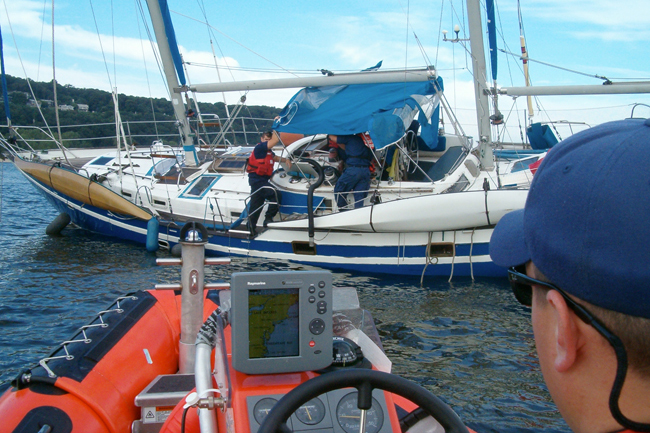 The sailboat crew was able to plug the holes and dewater the vessel, preventing it from sinking.
The sailboat crew was able to plug the holes and dewater the vessel, preventing it from sinking.
Sudden Flooding Calls for Fast Action and Special Tools
Consider this: you’re drifting along, summer breeze caressing your face, sunlight dancing off the water, and – thunk! – a distracted angler bangs his bass boat into yours. Or – crunch! – your cabin cruiser comes hard aground on a submerged rock. Or – ptui! – a corroded thru-hull fitting pops out. Suddenly more water than you ever thought possible is pouring through a hole in your boat’s hull. What to do?
If you’ve thought about flooding when putting together your on-board emergency kit, and if you’ve trained yourself to handle this kind of crisis, then you have a good chance to make it back into port. If not, then it’s an especially good thing you and your passengers chose to wear those life jackets.
The amount of time a boat operator has to respond to sudden, uncontrolled flooding depends strongly on the size of the hole and its location below the water line – the lower the hole, the greater the incoming pressure. A one-inch hole in the hull just one foot below the surface floods at a rate of about 20 gallons a minute. That same small hole six feet below the surface floods a nearly two and a half times that rate. And larger holes?
Well… let’s just say you need to act very fast. Adding flood damage control to your vessel’s emergency kit needn’t be expensive. You may find most of the supplies and tools already at hand. For recreational boats, a flood damage-control kit starts with an assortment of the following:
Plugs and patching material: wooden wedges and tapered wooden plugs in a variety of sizes to match the boat’s thru-hull fittings; an assortment of rubber sheets and gasket material; rags, waterproof putty, and other filler for stuffing in and around patches for a better seal.
Fasteners to hold the patch in place: hose clamps, nylon ties, twine, grease tape, fiberglass tape, and duct tape.
Tools to make it all happen: screwdrivers, a hacksaw, an adjustable wrench, pipe wrench, nut driver, and a hammer. These are not just to help patch the hole but to help close watertight doors and hatches, shut down machinery that could make a flooded area hazardous, and close off drains and discharges that can siphon water into the boat if they sink below the water line. Also, since bilge pumps aren’t designed to handle the large volumes of water caused by a hole in the hull, a dewatering pump is a recommended investment.
All of these, along with other emergency kit components, need to be in a container that’s clearly marked and close at hand. Attach a flashlight to the handle should an accident happen at night, and make sure everyone on board knows where the emergency kit is located.
Careful maintenance and regular inspection of pipes, gaskets, valves, and fittings can greatly reduce the chance that mechanical failure will lead to flooding. Boating education and knowledge of navigation rules and local conditions will minimize collisions, allisions (running into fixed objects, like the pier), and hard groundings. Still, there’s no substitute for preparation. Vessel damage control training is widely available through the U.S. Coast Guard Auxiliary and other boating groups, and the local harbormaster or U.S. Coast Guard office can direct you to course offerings nearby. Once you are trained, hold a monthly drill to practice quick action in an emergency. And don’t forget the most important step in damage control: communication. Notify the Coast Guard and other boaters in the area if your boat is taking on water. Make sure you and all of your passengers are in life jackets. Saving your boat is important – but if flooding can’t be brought under control, the priority is saving lives.
The U.S. Coast Guard reminds all boaters to “Boat Responsibly!” For more tips on boating safety, visit USCGboating.org
